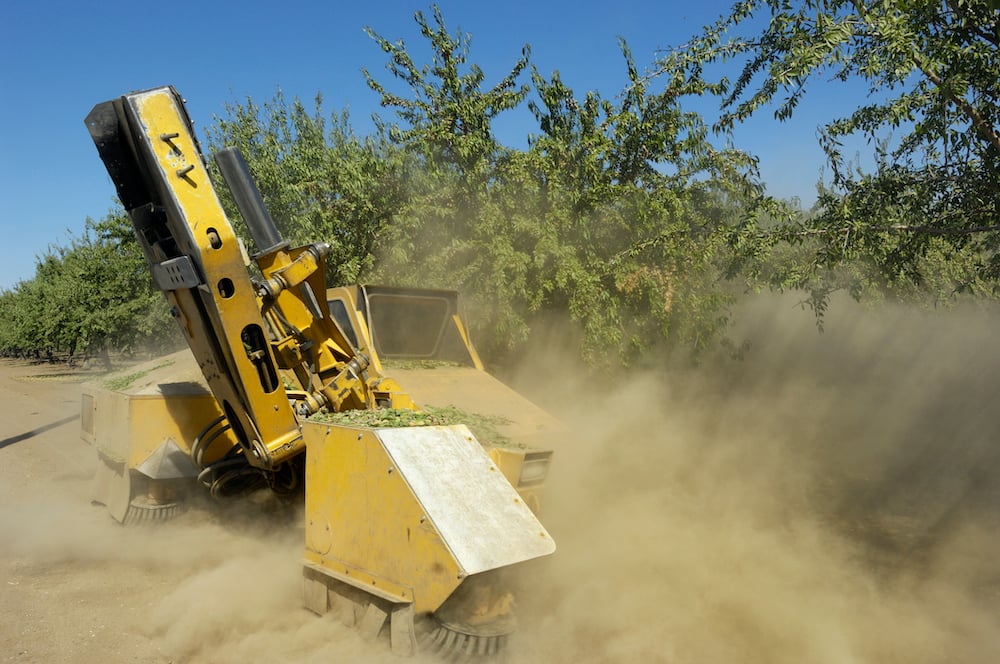Being part of the world’s largest almond-growing region means dust management is a real concern in California’s San Joaquin Valley. The region has long struggled to meet federal air quality standards for particulate matter. In addition, as tree nut acreage expands, many working orchards now border suburban areas and commuter roads.
Especially in orchards close to populated areas, dust can rise to the level of a public nuisance during harvest. Surface harvesting of nut crops is a significant source of PM10 and PM2.5 emissions (particulate matter measuring <10 micrometers and <2.5 micrometers, respectively). Large plumes form from the shaking, sweeping, and picking up of tree nuts, including when harvesters sort nuts from dirt and other debris.
Orchard operations do have the ability to reduce their impact: the Almond Board of California found a 50% reduction in dust resulted from slowing a 3-mile-per-hour harvest pick up to 1.5 miles per hour. Even for growers unable to reduce their speed, small changes can go a long way to reducing dust.
Clean floors, planned routes
Research funded by the Almond Board of California has shown the importance of starting with a clean orchard floor. Holes or ruts caused by equipment or pests should be filled in prior to harvest: this allows the necessary suction fan speed on pick-up machines to be reduced, which in turn reduces dust pollution.
The canopy can act as a natural filter to keep down dust. With that in mind, growers can plan ahead for a harvest route that maximizes opportunities to blow dust back into the orchard, rather than toward neighboring development. Mapping a route can also help minimize unnecessary blower passes.

Proper calibration
Harvest conditions differ from season to season, and adjusting equipment to account for these changes can help reduce dust.
Blowers with lower RPMs on separator fans produce less dust, and sweeper heads that use metal tines only are more effective at reducing dust than those that use rubber flaps. Sweeper heads should be set to the maximum effective height for getting nuts off the ground: too low and the sweepers will be moving dirt and kicking up dust unnecessarily. According to the Almond Board, this can be as high as 0.5”.
Transitioning to low-dust
Equipment manufacturers are developing harvesting technology to reduce dust. Equipment design changes can be found in both pull-behind PTO and self-propelled models, with improvements made in fan speeds, cleaning chains, vacuum chambers, misting, and other attributes.
In order to qualify as a "low-dust” harvester, the manufacturer must report a minimum of 30 percent fewer PM10 emissions than that of a conventional harvester. The USDA Natural Resources Conservation Service awarded research grants to Texas A&M University to demonstrate four low-dust harvester technologies at a single almond orchard in Kern County. A similar field demonstration was conducted in Fresno County in collaboration with the Almond Board of California and the San Joaquin Valley Air Pollution Control District.
According to USDA spokesperson Amanda Heitkamp, “Both these demonstrations showed that PM10 and PM2.5 were reduced without affecting product quality." Though variation in site conditions can affect the control efficiency of newer technologies, the demonstrations reported 35-76% reduction in PM10 emissions, and 41-62% reduction in PM2.5 emissions when compared to a conventional surface harvester.
This webinar from the California Almond Sustainability Program walks through the details of eligibility for dust-reduction incentive programs.
Today, a range of programs exist to help growers transition to certified low-dust harvest equipment—and there are indications that these incentives are working. In 2019, the Central Valley experienced a nearly 70-ton reduction in PM10 emissions during a record-breaking harvest season of nearly 20,000 acres of almonds.
